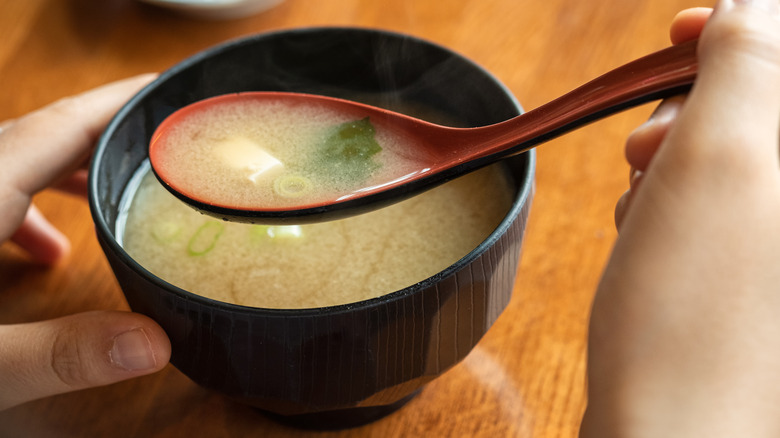Nail Miso Soup Every Time By Getting The Simple Paste-To-Water Ratio Right
Miso soup is one of the most comforting dishes out there. Fortunately, it doesn't take a ton of effort to make, since it just requires dashi (a clear soup base of dried bonito flakes and dried kelp), tofu, seaweed, green onion, and of course, miso. But you will want to abide by a few rules so that your soup tastes like the Goldilocks version you were hoping for. Part of this is pinning down the amount of miso that goes into each serving — if you add too much, you get a salty sip of broth; if you add too little, your soup will taste plain-bodied and watery. We spoke to Kimono Mom, a Japanese home cooking influencer and founder of the popular Umami Sauce product, about ways to ensure your miso soup is just right.
She tells us that there is indeed an ideal amount of miso to use for the broth. "I like to remember it as 'dissolve miso at a 1:10 ratio.' The salt concentration most people find delicious is about 0.8–1%. A typical miso soup cup holds about 160 ml, so 1 tablespoon (15–16g) of miso makes a well-balanced soup." But something Kimono Mom does note is that miso varieties can come with different salt levels, which means you may need to taste and adjust as necessary.
Here's what to look for when purchasing miso for soup
Because Kimono Mom eats miso regularly, she makes sure to look for the most natural and traditional-style products available. She says she prefers ones with a simple ingredient list, and suggests one thing: "Check the label. Ideally it's made from soybeans, rice or barley, koji, and salt only, using the traditional method."
She also prefers unpasteurized miso (labeled "nama"), because she says, "Miso is a fermented food, rich in enzymes and lactic acid bacteria, which can help with gut health, skin, and lifestyle disease prevention. Pasteurization destroys these enzymes, so unpasteurized miso is better."
And if you're looking for a deeper umami flavor, you'll want to go with an aged miso, which will be darker in color. If you prefer a lighter flavor, a shorter-aged miso would be ideal for you. It's really a taste preference thing, and considering miso paste is a useful ingredient at home (try making miso butter spaghetti carbonara with it), you'll have plenty of ways to use up what's left.
The last tip involves the actual cooking of the miso soup. There's one important thing you'll need to do, and that's turn off the heat prior to dissolving it into the heated broth base. Kimono Mom says, "Some people strain it through a sieve, but I often just drop it into the broth, let it sit for 1–2 minutes, and then stir, it dissolves easily." Now that you've been armed with this information, hopefully your miso soup just got better.

